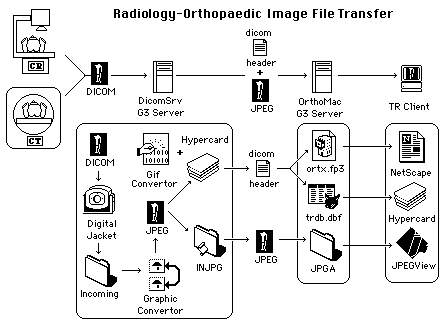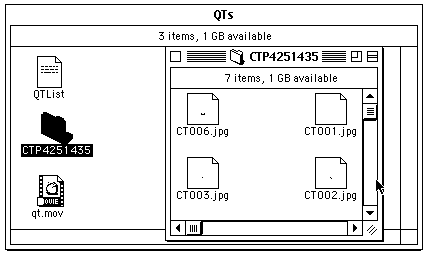
A mechanism for the direct import and JPEG conversion of Radiology PACSDICOM images has been established for the following reasons.
Xray Archiving
Recently, the Radiology LAN (local area network) has extended a 100 MBethernet connection to a node in the MCS Orthopaedic Brooks Center. TheRadiology LAN is a subnetwork of the VUMC network.
In addition to the usual routing of digitized xray images (DICOM files)to the Radiology Department's DICOM Archive, Radiological DICOM devices(such as CR (computerized radiography and CT units) may now also route thesame digitized xrays to a G3 Macintosh server (DicomSrv) connected to theextension of the Radiology LAN in the Brooks center. DicomSrv uses DigitalJacket, a DICOM compliant Storage Service Class Provider, to 'listen' forstorage requests from appropriately configured DICOM devices on the Radiologynetwork and stores copies of such images within the "Incoming"desktop folder on the DicomSrv Macintosh G3.

As depicted above, the "Incoming" desktop folder is also designatedas a GraphicConvertor application "drop" folder which immediatelyJPEG converts all incoming DICOM images, transfers the DICOM header demographicdata to the JPEG "Comments" window and moves the converted JPEGSinto an "INJPG" desktop folder. Using a "folder action",the addition of any new JPEG file to the "INJPG" desktop foldertriggers a cyclic Hypercard Hypertalk and Applescript mediated process whichdirects GIFConvertor to open, read and parse the DICOM demographic header data(in the JPEG "Comments" window).
With the extraction of the medical record number, a Hypercard/FileFlexlook-up of a corresponding in-patient record is performed across the Radiologysub-network and VUMC Hospital network amongst the patient data stored onthe "OrthoMac" Macintosh G3 server. If a matching record is notfound within 48 hours, the JPEG file in question is deleted from the "INJPG"folder on DicomSrv.
If a corresponding patient record is found, a Rinaldi Hypercard externalcommand (URLAccess) is called to create a new image record in a FilemakerPro web served "ortx.fp3" database inputting the parsed demographicDICOM header data. The path to the corresponding JPEG file which is copiedover the network to the "OrthoMac:Trauma Register:JPGA" folderis also specified within the Filemaker Pro record in such a way that webpage representation of the record includes a hyperlink which opens the associatedimage in a java and javascripted image viewing window.
Through Hypercard FileFlex external commands, the parsed demographicDICOM header data is written to the "trdb.dbf" Fox Pro table withinthe "Trauma Register:TR Fox" folder on "OrthoMac" insuch a way that the image may be opened and edited by Hypercard mediatedimage viewing (JPEGView) and editing (GraphicConvertor) applications.
CT and MR Archiving
The procedure in terms of landing DICOM CT or MR files (slices) on theDicomSrv Macintosh G3 server and the conversion of such slices to JPEG formatis similar to that described above for Xrays.
Once a DICOM CT or MR slice is JPEG converted and moved to the "INJPG"folder, a "folder action" activates Hypercard to read each file'sDICOM header data with the "GIFConvertor" application. Files withnames containing "CT" or "MR" are moved to a newly createdfolders with names derived from the study type + the file medical recordnumber (e.g. CTP4251435) within a DicomSrv desktop "QTs" folder.

Upon the completion of cycling through and processing of all files inthe "INJPG" desktop folder, Hypercard is directed to the "QTs"desktop folder. If a folder within the "QTs"" desktop folderhas a modification date and time stamp greater than 15 minutes old, it isassumed that no further CT or MR slices will be added to that particularfolder because such files are usually sent from the DICOM appliance in rapidsequence.
If a matching inpatient medical record number can be found on the "OrthoMac"server, Hypercard rewrites the "QTList" text file within the "QTs"desktop folder to include all return-delimited paths of all files withinthe JPEG slices folder (e.g. CTP4251435 - i.e.)
Hypercard activates a "Debabelizer" Batch Mode "jpgmov"script which uses the "QTList" text file to sequentially selectJPEG slices and combine them into a QuickTime Movie file (qt.mov) format.The usual settings are flattened CinePak, 256 grays, 2 frames/second. Thecompleted Quicktime CT Or MR movie is then renamed and copied to the "OrthoMac:TraumaRegister:JPGA" archive folder where it is hyperlinked to OrthoMac'sHypercard INPT stack, the "trdb.dbf" Fox Pro database and theFileMaker Pro web-served "ortx.fp3" database is the same mannerdescribed for xrays.
Subfolders and qt.mov's of DicomSrv "QTs" desktop folder notmatched with inpatient records within 48 hours are deleted.